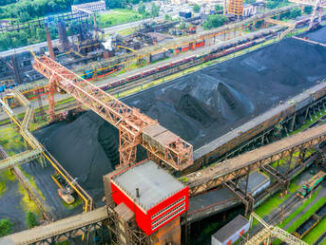
- Indonesia burned 33% more coal in 2022 than the year before, contributing to a 20% increase in the country’s carbon emissions from fossil fuels, an analysis of official data shows.
- This will likely catapult Indonesia to become the world’s sixth-highest fossil CO2 emitter, behind Japan, according to the analysis.
- This rise in coal burning aligns with efforts to boost economic recovery following the COVID-19 pandemic, including the slate of new coal-fired power plants that recently came online as well as the expansion of the nickel industry.
- Industrial parks that are home to smelters processing nickel and other metals consume 15% of the country’s coal power output.
JAKARTA — Indonesia burned more coal in 2022 than any other year, a preliminary analysis shows, putting the country on track to become one of the largest carbon emitters from fossil fuel in the world.
Data from the Indonesian Ministry of Energy and Mineral Resources showed that coal consumption amounted to 745.72 million barrels of oil equivalent (BOE) in 2022, a 33% increase from 558.78 million BOE in 2021.
The data shows the country’s coal consumption to be the highest ever by a very large margin.

Using this data, researchers from the Global Carbon Project, an organization that seeks to quantify global greenhouse gas emissions and their sources, measured the emissions that came from that increase.
Coupled with other increases in fossil fuel consumption, such as oil (12%) and gas (1.2%), these increases drove Indonesia’s total carbon dioxide equivalent (CO2e) emissions from fossil fuels to grow by 20.3%, according to Robbie Andrew, a member of the Global Carbon Project and senior researcher at the Norway-based CICERO Centre for International Climate Research.

That put Indonesia’s total CO2e emissions from burning fossil fuels at 619 million metric tons, with Andrew describing both the growth in coal consumption and emissions as “strong” and “massive.”
“None of the world’s top-ten largest emitters has seen growth of 20% in the last 15 years,” Andrew told Mongabay.
In 2021, Indonesia’s emissions from fossil fuels were the ninth largest in the world, according to data from the Global Carbon Project.
With the increase in its fossil fuel emissions, Indonesia has become the world’s sixth-highest fossil CO2 emitter, behind Japan, Andrew said.
Using preliminary data, Indonesia’s fossil fuel emissions is estimated to surpass those of Saudi Arabia, Iran and Germany.
“However, Indonesia is only very marginally ahead of Saudi Arabia and Iran: all three countries have about the same emissions, but our estimates show Indonesia highest of the three because of its large increase,” Andrew said. “The interesting question will be what happens in 2023. If Indonesia grows sharply again in 2023, then it will probably move more clearly into sixth place.”
The Ministry of Environment and Forestry’s climate change department did not respond to Mongabay’s request for comment.
While Indonesia’s fossil fuel emissions had increased sharply, its fossil fuel emissions per capita, at 2.7 tonnes, is still much lower than that of the U.S, at 15 tonnes.

Emissions targets undermined
This rise in coal burning is fueled by efforts to boost economic recovery following the COVID-19 pandemic, including the slate of new coal-fired power plants that recently came online as well as the expansion of the nickel industry — a strategic priority for the government as it looks to assert itself in the global supply chain for the batteries powering electric vehicles and other green technology.
Indonesia is already the world’s third-largest coal producer and a major coal consumer as well. That consumption will continue to rise through 2029 as new coal plants continue to be built and go online, according to the Institute for Essential Services Reform (IESR), a policy think tank based in Jakarta.
Another factor is the lack of efforts to phase out or even slow down coal mining, despite the government’s stated ambitions of achieving net-zero emissions by 2060. Grita Anindarini, program director at the Indonesian Center for Environmental Law (ICEL), noted that the government is instead targeting an increase of nearly 5% in coal production this year.
If Indonesia’s coal consumption continues to rise, so will its emissions from burning fossil fuels, said IESR executive director Fabby Tumiwa. And this, he said, will jeopardize Indonesia’s target of having its emissions from the energy sector peak in 2030.
That target is a part of Indonesia’s greater ambition to transition from fossil fuels to renewable energy and is enshrined in a historic deal struck in November 2022. Under that deal, known as the Just Energy Transition Partnership (JETP), the G7 group of industrialized countries, plus Denmark and Norway, agreed to provide $20 billion in funding to Indonesia to help it speed up its energy transition.
Experts say Indonesia’s energy transition agenda is particularly important for the global target of limiting temperature rise to 1.5° Celsius (2.7° Fahrenheit) above pre-industrial levels, as the country is one of the world’s largest emitters.
The JETP funding is meant to help Indonesia cap its emissions from the power sector at 290 million metric tons by 2030, faster than its initial goal of 2037. This is supposed to be achieved by retiring existing coal-fired power plants and freezing new power plant projects.
But if the volume of coal being burned continues to rise, “then our emission cap target in 2030 will be difficult to achieve,” Fabby told Mongabay.
“The more difficult it is, the higher the mitigation cost will be. If that’s the case, we can’t reduce our emissions [as it’s too expensive]. So our emissions will continue to rise,” he said, warning of a vicious cycle.

Burning more coal to catch up
As factories slowed their production during the COVID-19 pandemic, energy consumption went down. The ongoing recovery has seen a rush to make up for this downtime.
“Coal consumption actually grew sharply in the two years before the pandemic, so the growth in 2022 is partly about recovery to Indonesia’s previous growth trajectory,” Andrew said.
That sharp increase pre-pandemic can be attributed to the many new coal plants that came online in recent years, Fabby said. These are part of President Joko Widodo’s flagship program of adding 35 gigawatts (GW) to the national grid in a bid to power Indonesia’s economy, the largest in Southeast Asia and the 17th largest in the world by GDP.
The program entails the construction of hundreds of power plants of various types. But the majority of the additional capacity, 20 GW, will come from 117 coal plants.
In 2015, when the 35 GW program was announced, Indonesia’s fleet of existing coal plants had a combined capacity of 25.4 GW. In 2022, that had increased by 60% to 40.6 GW, according to a 2023 report by Global Energy Monitor.
So a sharp post-pandemic increase to catch up to the pre-pandemic level of coal burning is to be expected, Fabby said.
“Many new coal plants started operating from 2019, so there’s a tremendous increase,” he said.
Another key reason is the increasing demand for coal in the metals industry. This is clear from other details in the energy ministry data, according to Andrew, with much of the increase driven by Indonesia’s nickel industry.


Fueling the nickel dream
Indonesia is the world’s largest producer of nickel, a key element in the lithium-ion batteries used in EVs and renewable energy storage. The Widodo government is banking on the country’s nickel reserves — estimated at about a quarter of the global total — to turn the country into an EV powerhouse.
Indonesia’s nickel production rose by 60% in 2022, accounting for half of global production. But this green ambition comes with a climate toll, given that the nickel industry is hugely energy intensive. And in Indonesia, the power grid is dominated by coal.
In 2022, 43% of Indonesia’s electricity came from coal, an all-time high, while renewable accounted for just 10% of the energy mix.
“In Indonesia … the carbon per kilowatt-hour of power generation is much higher than most of the rest of the world,” Andrew Digges, Asia partner at global law firm Norton Rose Fulbright, said as quoted in the Financial Times in September 2022. “If we compare to Canada … Indonesia will, by 2030, produce about eight or nine times as much carbon per kilowatt-hour of electricity as Canada will.”
Indonesia’s industrial parks, particularly those on the islands of Sulawesi and Halmahera that have become major hubs for nickel and aluminum processing, are also heavily reliant on coal. They consume 15% of the country’s coal power output.
Furthermore, Indonesia’s nickel reserves are the laterite ore kind, which require more processing to become battery-grade nickel than does the sulfide ore found mostly in Canada, Russia and Australia.
As a result, making battery-grade nickel, also known as Class 1 nickel, in Indonesia is much more carbon-intensive than elsewhere; producing Class 1 nickel from Indonesia’s laterite ore resources releases two to six times the amount of CO2 emissions as producing Class 1 nickel from sulfide deposits.

Held captive by coal plants
The rise in coal consumption comes as new smelters to process nickel and other metals spring up across the country. Construction on most of these began in 2017 and 2018, and with operations beginning in 2019 onward, according to Fabby.
To power these smelters, coal-fired electricity plants are built specifically to serve them, known as captive plants. By definitions, therefore, these are plants that can’t be shut down without shutting down the industries that they power, Fabby said.
“If they’re shut down, the smelters will also cease operation because there’s no replacement [power source] yet,” he said. “It’s not easy to replace them because there’s a need to build new infrastructure. So technically and economically speaking, it’s not easy.”
He called on the government and industries to stop building new coal plants altogether, whether feeding into the national grid or captive.
“Once coal plants are built, it’s difficult to retire them before their expected end of age,” he said. “And it’ll be more difficult and costlier to build the infrastructure to replace them. So the best and cheapest option is to not build fossil fuel infrastructure if there’s no need for them. Or if there are plans to build them, cancel and replace them with renewable energy so that we can achieve our emissions cap target in the power sector.”



